Matador Network's Blog, page 143
July 22, 2024
The best luxury forest accomodations
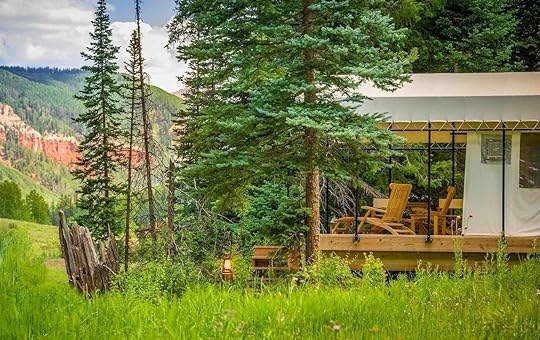
For generations, Americans have ventured into the vast, ancient forests of the United States seeking spiritual, emotional, and physical rejuvenation, indelibly blending the concepts of restoration and peace with being in the woods. That notion of forest wellness still persists to this day, but instead of decamping into the woods to sleep in a tent or going off the grid, the idea of a forest retreat has evolved to include all plush perks we now associate with wellness: extravagant dwellings, stone hot tubs, fine dining, and even air-conditioning. Luxury forest retreats across the United States are rapidly becoming the best way to discover the charms of the forest, combining relaxation with only the best amenities that money can buy. From glamping tents to upscale treehouses to elegant Western-style cabins, these are the top luxury forest getaways in the US.
The Resort at Paws Up — Greenough, Montana
Photo: The Resort at Paws Up/Facebook
Set on a 37,000-acre working cattle ranch in western Montana, where mountains and pristine forests give way to vast plains under endless skies, the Resort at Paws Up has long had a reputation for high-end backcountry retreats with its deluxe cabins and equestrian-themed activities. But the best way to experience the Montana wilderness is by staying in its fancy glamping tents.
Set in a variety of locations around the huge ranch — from the middle of the forest to woodsy creek-side overlooks — the safari-style but Wild West-themed tents (which range in size from 500 to over 1,000 square feet) come outfitted with features like freestanding bathtubs, plush king beds, indoor air-conditioned seating areas, and large front decks with Adirondack chairs. The camps come with their own chefs who prepare “refined rustic ranch” meals, but you can also check out the resort’s many restaurants and culinary activities. During the day, guests can take part in resort activities like horseback riding and fly fishing, or take short drives to explore the nearby national forests or Glacier National Park.
Blackberry Mountain — Walland, Tennessee
Photo: Blackberry Mountain
Opened earlier this year to great acclaim, Blackberry Mountain is the sister property of the beloved Blackberry Farm, famed for its farm-to-table cuisine and backcountry Tennessee charm. But this bucolic 5,200-acre resort — surrounded by virgin forests in the heart of Tennessee’s Great Smoky Mountains — takes the concept one step further by wholly embracing the wilderness’s role in rejuvenation and wellness through rugged daily outdoor activities like hikes, mountain biking, rock climbing, and canoeing. There are also less strenuous activities like chef-led hikes where gourmet meals are prepared trail-side.
At the end of the day, guests return, weary but content, to the lodge for wholesome, farm-fresh meals at the two restaurants, specialty treatments in the underground spa, and soaking up the top-of-the-world views from the outdoor infinity pool, before retiring for the night to either a grand Watchman Cabin or an elegantly rustic Stone Cottage. And if you’re too tired to walk from the main lodge to your cabin, don’t worry; just have one of the on-site Lexus cars take you.
Mohonk Mountain House — New Paltz, New York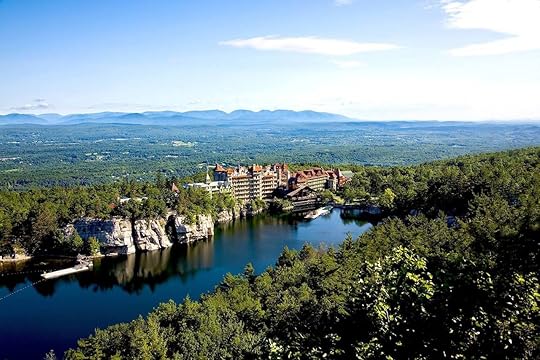
Photo: Mohonk Mountain House/Facebook
For generations, upstate New York has been the last word in combining summer fun like hiking and water sports with only the best in lodgings, cuisine, and amenities. And one of the absolute finest places to retreat from the hustle and bustle of the world is at the Mohonk Mountain House in the Hudson Valley, just 90 miles north of NYC. The European-style resort, which overlooks Lake Mohonk, was first built in 1869 and has over the years been vastly expanded to the castle-like wonder it is today, with 259 plush, Victorian-styled rooms; farm-to-table dining; a spa; indoor pool; and outdoorsy activities like hikes through the nearby 40,000-acre woodlands, boating, fishing, and kayaking.
Twin Farms — Barnard, Vermont
Photo: Twin Farms/Facebook
Surrounded by the peaceful silence and tranquil views of 300 acres of pristine Vermont woodland, the five-star, all-inclusive Twin Farms resort is well worth its hefty price tag. The main resort is housed in a historic farmhouse from the late 1700s but sumptuously upgraded, with additional cabins, cottages, and suites located nearby. The aesthetic themes vary from room to room, with some harkening back to the resort’s historic New England roots while others go for a more refined, ultra-modern feel, and each space has its own unique amenities like stone hot tubs and large, forest-view windows. At the main lodge, guests partake in decadent meals prepared with local ingredients and can relax at the spa or take part in daytime activities like a tour of the resort’s bee farm or going cycling with a gourmet picnic.
Post Ranch Inn — Big Sur, California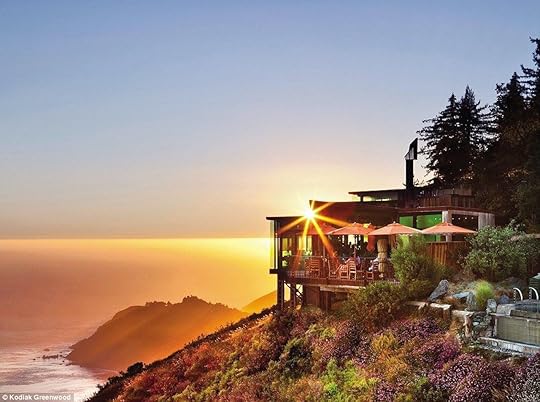
Photo: Post Ranch Inn/Facebook
While the Post Ranch Inn made its name with its artsy contemporary bungalows, suites, and guesthouses perched 1,200 feet above California’s scenic Big Sur coastline, the wooded interior of the 100-acre property also houses several luxury treehouses. Elevated nine feet above the forest floor, the treehouses allow for complete forest immersion with stargazing skylights over the beds, private mountain-viewing decks, and large windows looking out on the surrounding woods. Similar to the other dwellings on the property, the staircase-accessible treehouses feature a sleek, contemporary design and other cushy amenities like a wood-burning fireplace, gourmet meals, restorative activities like hiking and yoga, and access to all of the resort’s features like the cliffside infinity pool.
ROAM Beyond — Washington State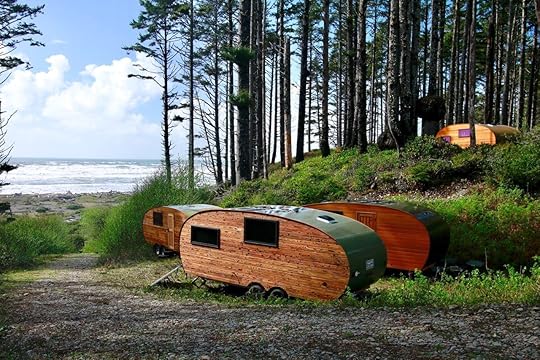
Photo: ROAM Beyond/Facebook
Often, gaining access to the most remote wilderness locations requires roughing it and then spending the night in an uncomfortable tent. But ROAM Beyond, a new Seattle-based glamping company, thinks that being able to escape to the woods shouldn’t mean having to sacrifice comfort and style, and has launched a network of off-the-grid glamping sites around Washington where guests stay in wooden boutique campers. All of the amenities for a high-end camping experience are provided and guests only need to bring personal items, desired food, and their sense of adventure. Each camper comes equipped with a queen bed, kitchenette area, a bathroom, and hot water, as well as camping essentials like cooking tools. Best of all, the campers — the outsides of which are beautifully paneled in dark wood and topped with gleaming steel — are sustainable, with solar power systems and composting toilets. Currently, there are only two sites open — on the Olympic Peninsula in Kalaloch, Washington, and North Bend, Washington — but there are plans to open more soon in places like Joshua Tree and Yellowstone National Park.
Under Canvas — Glacier National Park, Montana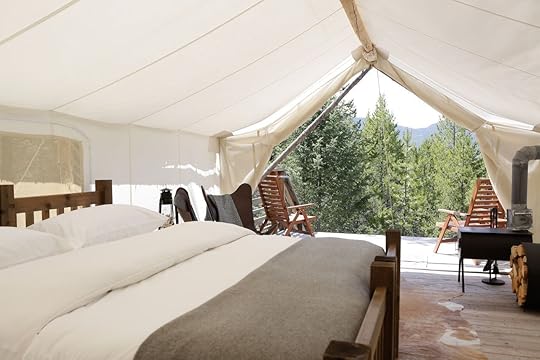
Photo: Under Canvas Glacier/Facebook
Ditching the standard safari-tent model for more whimsical designs, Under Canvas is earning quite the reputation for its glamping destinations around the US, but its site near Glacier National Park is one of the best. Hidden inside of a pine forest just a short drive from the park, its deluxe tents are especially suited for vacationing families or large groups, as the spacious tents feature en-suite bathrooms and multiple beds. A large front porch with leaning chairs offers relaxing views of the surroundings, and wood-burning stoves keep the tents nice and warm at night. While it’s easy to get out and explore Glacier on your own, Under Canvas also has its own activities like llama trekking and rafting.
Dunton River Camp — Dunton, Colorado
Photo: Jack Richmond/Dunton Destinations
There is no shortage of opulent cabins and forest escapes in Colorado. But the Dunton River Camp still manages to stand out from the pack. Housed on a 500-acre former cattle ranch, Dunton’s eight luxurious, safari-esque tents allow guests all of the comforts and amenities of a high-end resort but in the middle of the San Juan Mountains’ immaculate nature. Guests can choose between staying in the Mountain or River tents (the Mountain ones are tucked away inside of the forest and offer mountain views) and come with a spacious front deck, king bed, en-suite bathroom, and contemporary Western decor. The resort is just a short drive from charming mountain towns like Telluride and tons of outdoorsy activities like hiking in summer and skiing in winter, but the resort does offer its own excursions as well, like horseback riding and fly fishing. 

Photo courtesy Pahaska Teepee Resort
The Pahaska Teepee Resort was at one time owned by Buffalo Bill Cody himself, so you know you’re experiencing the true west here. The resort combines a unique blend of rustic charm with amenities like a spa and guided excursions on horseback, as well as fishing and cross-country skiing right from your doorstep. The resort also features a spa where you can unwind and rejuvenate after a day of exploration. The accommodations range from cozy cabins to the iconic teepee-inspired rooms, ensuring a memorable stay for every traveler.
The Grand Hacienda Luxury Inn and Gourmet Breakfast — Youngsville, New Mexico
Photo courtesy Grand Hacienda Luxury Inn
This secluded boutique estate offers three luxurious guest suites, each meticulously designed to harmonize with the surrounding landscape. You’re immersed in the flora and fauna of the high-desert landscape, in comfort with amenities like a shared full kitchen, a cozy great room with a kiva fireplace, and common outdoor spaces. Unwind in the hot tub, roast marshmallows by the fire pit, or have a drink while taking in the views of Abiquiu Lake. The small number of guests onsite at any given time makes everything from the customer service to the breakfast (the gourmet breakfast is part of the official name of the property, after all), quite personalized.
More like thisEpic StaysThe Cutest Tiny Houses to Rent in the Pacific NorthwestHow Unpacking Your Suitcase at Your Hotel Can Lead to Bed Bugs

While many travelers know to check for bed bugs in hotels beds before laying in them, not seeing any on the mattress, boxspring, or headboard does not mean there are not any in the room. Because, despite their name, beds are not the only place where the critters live.
According to the Center for Disease Control (CDC), bed bugs tend to live within eight feet of where people sleep, including in all sorts of pieces of furniture, especially if they have cracks and crevices, including dressers. Instagram’s Dr.Jayson comfirms it in a recent video.
View this post on InstagramA post shared by Jason Singh, MD (@drjaysonisfresh)
So if you have the habit of unpacking your belongings into the hotel room furniture instead of keeping it in your suitcase, you should probably stop. You should also refrain from putting your suitcase on top of the hotel bed or on the carpet to make sure it does not get contaminated. Traveling with a hardshell case instead of a softsided one is also a good preventive measure as the bugs are less likely to get into your stuff.
While ingenious solution to fight bed bugs are available, including Spotta, a 24/7 bed bug detection device which top hotels around the world already use, travelers should stay alert and always make sure to check their hotel rooms thoroughly before they settle. 
These Easy Packing Hiking Shoes Are Built for Summer Adventure, From Trail to Town

Many Colorado residents approach every weekend like an outdoor challenge. Snow sports in the winter, climbing, mountain biking, and hiking in the summer. My approach since moving to Denver in 2021 has been much more laid back, but I’m no stranger to throwing myself into a hike that ends up far more difficult than intended. The Ridgeway Mesh Low from Xero Shoes has kept me ready for it all through these first warmer months this year and are easy to pack for any adventure — from the trail to the brewery.
Xero was started by husband and wife team Steven Sashen and Lena Phoenix in Boulder, Colorado, as Feel The World, Inc. in 2009. Steven had turned to barefoot running to combat sprinting injuries after being given the book Born To Run by Christopher McDougall. After a couple of classes with the Boulder Barefoot Running Club, he realized the running style did help with injuries, but there are a whole lot of places where bare feet simply aren’t feasible. So he made some huarache running sandals using Vibram for the running sole.
Fast forward half a year and the two had a shoe company (first called Invisible Shoes) and consultation from designers from Nike and Reebok to design FeelTrue outsoles. Today, an iteration of that original huarache is still on the site. Xero also has a wider range of hiking shoes and casual footwear sold around the world, from road runners to hiking boots ready for adventure right out of the box to the Ridgeway Mesh Low.
We hope you love the products we recommend! Just so you know, Matador may collect a small commission from the links on this page if you decide to book a stay.
Buy Now: $119.95Testing the Xero Shoes Ridgeway Mesh
Photo: Nickolaus Hines
Shortly after unboxing the shoes, I took them on a weekend trip to a cabin just outside of Breckenridge. I tied them tight to walk a few miles, mostly on a paved surface, into town with my one-and-a-half-year-old strapped to my back for a nice dinner at Radicato. The shoes are light — about 11 ounces — and have a sleek profile that doesn’t feel out of place at a nicer restaurant. Just as importantly, they’re comfortable.
I know I’ve landed on the right shoes for the moment when no amount of walking starts to chafe and I don’t have to think about fitting in with the crowd (I wouldn’t try to pull them off for a truly fancy occasion, but mountain fancy is no problem). If it weren’t for the small pops of bright-orange on the heel, the trail shoes would be near indistinguishable from your standard everyday shoe.

Photo: Nickolaus Hines
A deeper test came the following month on a family trip to Sitka, Alaska. Again with my baby on my back, my group set off on Harbor Mountain Trail to the alpine cabin and Gavin Hill trail. The five or so miles on the moderate hike wind through forest and out to the peaks overlooking the water until culminating at an alpine hut with an elevation gain of about 1,000 feet.
It’s an easy place to get caught up in the views. Wildflowers lined the first half of the path in early July. Farther up, the trail climbs to the treeline tracing the ridge, and the subalpine environment turns from spongy muskeg to rocks that can get slick in the misty cloud cover, and then rock stairs up to the top by the hut.
None of it was a problem for the grippy outsoles, even with a toddler who gets easily distracted and likes to lean side to side for a closer look at each passing flower, interesting (and also not that interesting) rock, bird, and bumblebee. I could feel the small scattered rocks and uneven surfaces through the thin TrailFoam midsole, but in a way that felt connected to the ground rather than uncomfortable. The shoes are flexible with a protective toe guard perfect for rocks and root-strewn dirt alike.
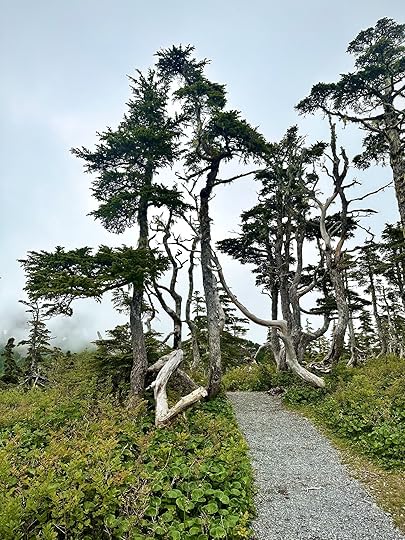
Photo: Nickolaus Hines
My long sleeve shirt was the wrong choice and I quickly sweat through it. My feet, however, remained cool thanks to the breathable, vegan-friendly mesh. Naturally, the Ridgeway Mesh Low were just as much a fit for a post-hike beer and pizza at Harbor Mountain Brewing, staying true to the trail-to-urban ethos that make the shoes so versatile.
On other days that trip, the salt spray from exploring tidepools dried and wiped clean quickly, and the sole gave just as much traction on the rocky coast of Washington even when sandy and hopping along pieces of driftwood.

Photo: Nickolaus Hines
An easy packing shoe that travels wellI’m a light packer, especially with the kid in tow when diapers and backup outfits claim half of my small Away carryon. The Ridgeway Mesh Low’s light weight and small, flexible profile easily squeeze into my luggage — no small ask when packing just a carryon for a nine-day trip through Alaska, Seattle, and Bellingham, Washington.
I don’t foresee jumping into the barefoot lifestyle anytime soon. Low-profile outdoor shoes with a thin sole are just right, though. They’ve quickly become my go-to for trips where I know I’ll be doing any sort of outdoor activities that don’t require ultra-specialized footwear. 
July 21, 2024
This Costa Rica Lodge Makes Sure Everyone Sees a Whale, or Gets a Free Massage
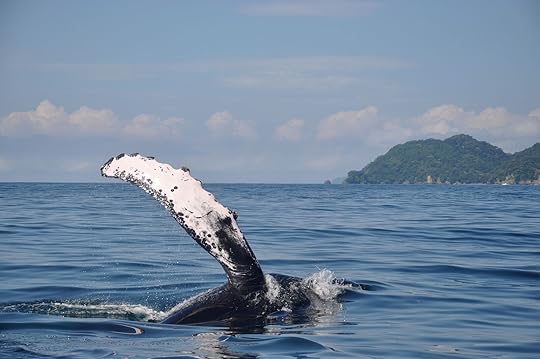
Costa Rica has lots of reasons to visit, from touring the famous cloud forests to epic beaches around Tamarindo and lush hikes to hidden jungle waterfalls. But if you’re a wildlife enthusiast, one of the main draws of visiting the country may be the high likelihood of spotting the country’s many whale species. Costa Rica’s waters boast an impressive whale population, with records indicating that up to 34 species of whales and dolphins call its coasts home.
That’s especially true around the country’s Golfo Dulce, a vital breeding ground for humpback whales along the southern Pacific coast in the Puntarenas Province. The humpbacks undertake the longest documented mammalian migration on Earth, traveling from Antarctica’s frigid waters to the Golfo Dulce’s every year between July and November. During this time, females give birth in the sheltered water, and males hang out in the outer gulf, anxious for breeding opportunities. The region is so well known for whales that the World Cetacean Alliance declared it a Certified Whale Heritage Site in 2022.

Photo: nuriajudit/Shutterstock
That draws thousands of travelers to the region, many of whom stay at resorts like Playa Cativo Lodge, just across from the Osa Peninsula. While it’s hardly the only luxury eco-lodge in the region, it just introduced a selling point that may give it a leg up against the competition, at least when it comes to drawing whale-focused travelers: a “whale warranty.”
The lodge offers lots of wildlife-focused activities, but guests who book the Dolphin and Whale-Watching Quest tour can feel pretty good about their chances of spotting humpback whales. Between August and October, if guests don’t see a humpback whale on the tour, they’ll get the tour fully refunded. And on top of that, to make the pain of not seeing whales a little better, Playa Cativo will give guests a free 60-minute spa treatment, too. With the whale warranty, guests can have the money back in their pockets, or put it toward wildlife activities like another whale-watching attempt, a nighttime rainforest hike, or a wilderness tour in Corcovado National Park.
View this post on Instagram
A post shared by Playa Cativo Eco-Luxury Lodge (@playacativolodge)
Rates at Playa Cativo Lodge between August and October start in the high $400s per night. If that’s too steep, travelers can always stay somewhere less expensive and book whale-watching tours through local companies based around Puerto Jimenez on the Osa Penninsula. 
July 20, 2024
New Viking River Cruise Routes Drop You at the Door of One of Kentucky’s Most Underrated Artsy Towns

On July 5, 2022, I boarded one of the coolest river cruise boats that ever sailed: the American Queen. The impressive 1995 recreation of a 19th-century paddle steamer took me and my partner on a journey along a small part of America’s most storied waterway: from Memphis to Nashville on the Mighty Mississippi.
It was only my second time in the United States and my first time in the American South. Our itinerary took us to some small towns along the river that I had never heard of before and would never even have considered visiting, including the very trendy and very underrated town of Paducah, Kentucky, which has since been awarded the title of UNESCO Creative City.
While American Queen Voyages, the cruise line that owned and operated the American Queen, is no more, Paducah is now on another cruise line’s itinerary: Viking.
Viking offers several sailings calling on Paducah: the Grand Mississippi Voyage and the Upper Mississippi Explorer in 2024, and the Big Easy to the Gateway City and the Mississippi River Odyssey in 2025.
Arriving in Paducah by the river is an incredibly easy way to see the best of this colorful, lesser-known destination. The port is right in the center of the small town, where everything worth a stop is within walking distance — and there’s a lot that’s worth stopping at.
Key stops for a day in Paducah’s city center Photo: Jesse Adams
Photo: Jesse Adams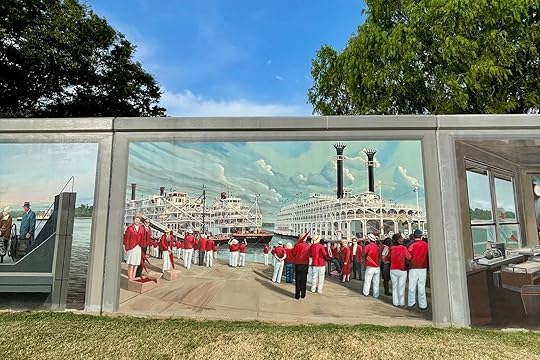 Photo: Jesse Adams
Photo: Jesse AdamsFirst on the itinerary is Paducah’s flood wall. Erected out of necessity to protect the town from the waters of the Ohio River, today, it’s one of Paducah’s most defining and interesting features. From the riverside, where the visiting vessels dock, the fortifications set the tone with a large white-and-red sign reading “Port of Paducah, KY – Welcome”. A large passage in the wall allows cruisers to come in and admire what the defenses look like from the other side. Like a never-ending multi-artist mural, every concrete slab has been beautifully painted to tell the story of the town. There’s barely enough time in one day to see them all in detail, but you should at least dedicate a couple of hours to it. I was lucky enough to be in Paducah when some of the artists were restoring their pieces and seeing them at work was a lucky treat.
 "Puffins" by Shirley P. Kelley. Photo: Jesse Adams
"Puffins" by Shirley P. Kelley. Photo: Jesse Adams "Forest Walk" by Pat Durbin. Photo: Jesse Adams
"Forest Walk" by Pat Durbin. Photo: Jesse Adams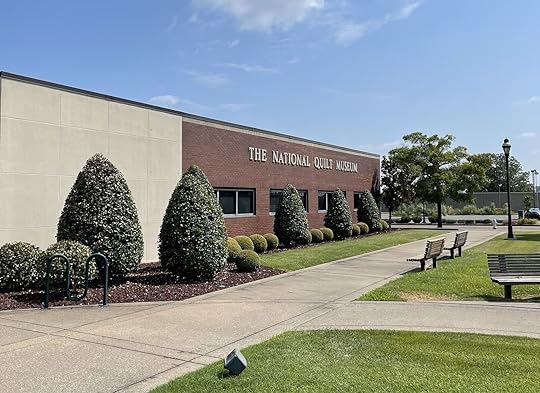 Photo: Jesse Adams
Photo: Jesse Adams Quilt made of wood by Fraser Smith. Photo: Jesse Adams
Quilt made of wood by Fraser Smith. Photo: Jesse AdamsNext up is the nearby National Quilt Museum, the pride and joy of the town and its claim to fame in the world of textile art — Paducah is also known as Quilt City USA, after all. Far from being a display of old-fashioned quilts, the National Quilt Museum is an art museum showing the world of incredibly talented creators who chose quilts as their medium of expression. Don’t pass on this place because you think you’re too cool for a quilt museum — you’re not. Everything about it is absolutely mindblowing, from the wood quilt in the foyer to the fun gift shop full of irresistible items (including quilts, of course).
 Photo: Jesse Adams
Photo: Jesse Adams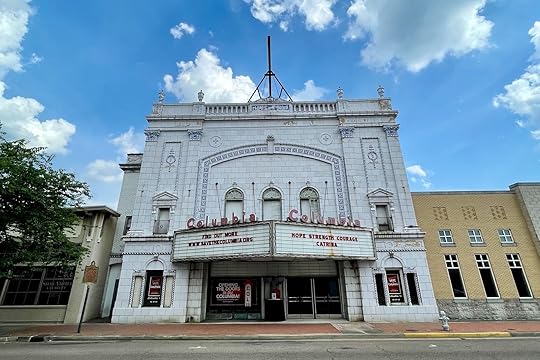 Photo: Jesse Adams
Photo: Jesse Adams Photo: Jesse Adams
Photo: Jesse AdamsFrom there, make your way to Broadway Street where you’ll find a ridiculously quaint gazebo on your right (a good place to find shade if you’re visiting in the summer), and historic buildings lining the street on your left. A multitude of independent shops and art galleries beckon you in for a browse, including PAPA Gallery and the Paducah Visitors Bureau where you can pick up a map and purchase local souvenirs. Explore the alleys, including Maiden Alley for a look at an old-fashioned movie theater, and Market House Square where you’ll not only find the historic Kirchhoff’s Bakery and Deli with its vintage sign and great pastries, but also a wealth of great artisan and creative shops, including Lepa Jewelry Design Studio & Boutique for hand-made, elegant jewelry and Bricolage Art Collective for various local creations and vintage clothing. Stop by the popular Etcetera Squared for a cup of coffee or a refreshing bubble tea. Walk farther up Broadway to look at the beautiful historic architecture on both sides of the stret and pop inside the many antique shops to find a local treasure. Three blocks off Broadway is Paducah’s city hall in front of which you can find the leafy and peaceful Dolly McNutt Memorial Plaza. Take the time to look at the sculptures and memorials paying homage to veterans who served in World War II, the Korean War, the Vietnam War, and the Global War on Terrorism.
In the same part of the town center, close to the flood wall and the port, also worth a look is the impressive Mikado steam engine parked by the flood wall — it’s a well-preserved piece of railroad history. While you should pass on the nearby Railroad Museum, if you have time, the kid-friendly Inland Waterways Museum is another good place to stop and learn about the river and the town’s relationship to it.
What to see outside the town center Photo: Jesse Adams
Photo: Jesse Adams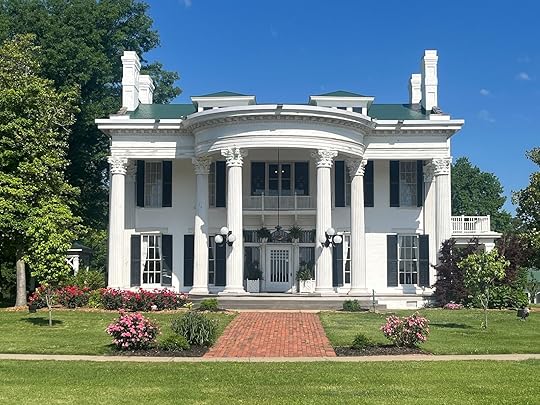 Photo: Zen Greenlee Horsemaship/Shutterstock
Photo: Zen Greenlee Horsemaship/ShutterstockOnce you’ve explored the center of town, head to the Lower Town Arts District. The neighborhood is only a 10-minute walk from Market House Square and you would be remiss to pass on the short stroll. The leafy streets of this quiet, residential area are lined with stunning grand historic houses, all surrounded by well-tended gardens and often flying pride flags on their porch, letting travelers know this is a safe place for everyone. The neighborhood, being home to the Paducah School of Art & Design campus, is an artsy, creative place, with more art galleries to check out. The Kitchens Café, located on the campus of the Paducah School of Art & Design on Harrison Street, is a great spot to stop for sustenance.
Some of Viking’s offered excursions in PaducahSome of the excursions offered by Viking in Paducah include a guided visit about the historical architecture of Lower Town to learn more about the beautiful buildings that make up the town center; a visit of the Historic Hotel Metropolitan, today an African American history museum listed on the National Register of Historic Places; and quilting classes to fully immerse in Quilt City USA. 
July 19, 2024
A Gorgeous Caribbean Island Is Getting Its First Direct Flight From the US

Turks and Caicos Islands, which include 40 islands south of Bermuda designated as a British overseas territory, are a popular tourist destination. They’re generally less crowded than other Caribbean islands, and are known for fantastic beaches, watersports like scuba diving and paddling, and excellent food featuring conch, one of the islands’ local specialties. There are eight airports scattered across the various islands, but that doesn’t mean it’s easy to get to, as only a select few offer realistic options from the US.
Until recently, the only option for Turks and Caicos airports for travelers coming from the US was Providenciales International Airport. It’s the largest and busiest airport in Turks and Caicos Islands, handling a significant volume of daily flights from the US, the Caribbean, and Europe. PLS serves as the primary gateway to the islands, and most visitors either stay in the vicinity of Providenciales (the most populated island), switch to a smaller flight to reach a domestic airport, or take a ferry to North Caicos.

South Caicos is less developed than most othr islands. Photo: Experience Turks & Caicos
But starting in February of 2025, visitors to the South Caicos can avoid an entire connection by flying on American Airlines directly from Miami. The flight launches on February 15 and will fly on Wednesdays and Saturdays. Flights will start around $210 each way, according to Google Flights.
While February may seem far away, it’s good timing for catching the most popular season in Turks and Caicos, running from about December to April. Winter on the islands has warm weather with low humidity, calm and clear seas ideal for watersports and snorkeling and diving, and a lively atmosphere with plenty of restaurants and shops open. Of course, it’s also the busiest and most expensive time to visit.
About the various islands of Turks and Caicos
South Caicos. Photo: Experience Turks & Caicos
Providenciales (known as Provo), is the largest and most developed island and the undisputed tourism hub. It’s known for luxurious resorts, pristine beaches like the iconic Grace Bay Beach, and a vibrant nightlife scene.
Closest to Provo is North Caicos, nicknamed the “garden island,” and considered a more lush and less-developed paradise. Limited lodging options consisting of eco-lodges, boutique hotels, and vacation rentals are where most people stay. Activities have an outdoorsy focus, including hiking, horseback riding, paddling through mangrove forests, and visiting historical sites like the Wade’s Green Plantation ruins.
Also popular is Grand Turk, the historic former capital. The island is steeped in cultural heritage, with a small-town atmosphere and the UNESCO World Heritage Site of Cockburn Town. Options for sleeping range from hotels and guesthouses to vacation rentals, and visitors can explore the Grand Turk Lighthouse and National Museum alongside excellent diving opportunities, particularly around the dramatic underwater reef system known as the Grand Turk Wall.
But thanks to now having a second international Turks and Caicos airport, the even-less-developed South Caicos is now a realistic travel destination. It’s more natural still than North Caicos, and caters to a specific kind of traveler: scuba divers or saltwater-flat fishers. On South Caicos, the focus is firmly on water-based activities, and most dive sites are pristine, thanks to their inclusion in the protected area called Admiral Cockburn Land and Sea National Park.
Where to stay on South CaicosView this post on Instagram
A post shared by Salterra, a Luxury Collection Resort & Spa, Turks & Caicos (@salterraresort)
Flying into the airport on South Caicos is useless if you can’t stay there, but the new flight is likely to encourage even more businesses to open on the pretty island. Currently, lodging options are somewhat limited and include convenient South Caicos Ocean & Beach Resort near Cockburn Town, and the gorgeous (if expensive) Salt Rock Resort, catering to well-heeled travelers looking for high-end dining and included activities. There are also several high-end home rentals on the northwestern part of the island.
However, one new resort is opening in time to take advantage of the increased accessibility of the Turks and Caicos’ second international airport: Salterra Resort & Spa. It’ll open in early 2025, with 100 beachfront rooms and six restaurants. It’s a renovation of the former East Bay Resort South Caicos, which closed in summer 2023. The resort will also run an on-site dive shop and school, making it the only dive operator based on South Caicos. 
All the Oregon Trail Hotspots You Can Visit on a Nebraska Road Trip

The Oregon Trail is legendary. No, not the video game cosplaying it, but the actual trail itself, which saw emigrants from the eastern United States depart from locations including Independence, MIssouri, and other midwest hubs in th3 1800s to reach the Willamette River at Oregon City, Oregon. Pioneers traveled by covered wagon for some 2,000 miles, facing river crossings, disease, and harsh weather along the way. The journey took most travelers about three months to complete.
Many of the trail’s most iconic stops and markers are in Nebraska, and the state has developed a series of museums, parks, and points of interest to highlight the Oregon Trail’s importance in American history. Four to five days is enough to take in the historical stops throughout Nebraska, with Interstate 80 serving as the spine of your trip. Fortunately, you can easily avoid the dysentery, adverse weather, and rugged river crossings the pioneers faced en route.
We hope you love this Nebraska Oregon Trail road trip! Just so you know, Matador may collect a small commission from the links on this page if you decide to book a stay.
Start in Fairbury
Photo courtesy Nebraska Tourism
The Nebraska Oregon Trail road trip starts in Fairbury, about three hours’ drive from the official start of the Oregon Trail north of Independence, Missouri. Begin the trek at Rock Creek Station State Historical Park, a lifeline for emigrants on the Oregon Trail. Surrounded by lush greenery, the spot offered travelers a chance to rest, resupply, and make repairs before continuing their westward journeys. In those days, it took caravans several days to get to Rock Creek Station from their launch point, and those days tended to be an initiation of sorts, as travelers were finding their footing. You can imagine that having a common stop to recoup and share trials and tribulations (and seek advice) was incredibly important in lifting morale for the rest of the trip.
The station provided essential goods like food, tools, and medicine, along with blacksmith services to fix broken wagon parts. This crucial stopover helped ensure the success of countless treks along the Oregon Trail.
Rock Creek Station’s significance extended beyond the Oregon Trail era. It briefly served as a Pony Express station in the early 1860s. Later, the station became a stop for the Overland Stage, another important transportation route in the West. Today, the park preserves this rich history through reconstructed buildings and well-worn wagon ruts.
Spend a few days in Kearney
Photo: marekuliasz /Shutterstock
Kearney is home to two important Oregon Trail sites. First is The Archway, which bridges Interstate 80. The Archway symbolically bridges the past with the present, standing at the very spot where the historic trail once intersected with modern highways. Inside, visitors can explore a self-guided exhibit that brings the Oregon Trail to life through life-sized figures and narration. But the Archway’s commemoration extends beyond the Oregon Trail. It acknowledges the rich history of the Platte River Valley, showcasing the evolution of transportation across Nebraska with exhibits on the Pony Express, the transcontinental railroad, and the Lincoln Highway. It opened in 2000 and is comprised of moving walkways and exhibits that document the life of trail emigrants.
After spending a day exploring The Archway, the best places to eat in Kearney are The Alley Rose, a steakhouse with an iconic salad bar, or Cunningham’s Journal On The Lake, a more casual taphouse and restaurant south of the city center.
In the morning, head to Fort Kearney State Historical Park to do some hiking and check out an old fort with an interpretive center and museum documenting the history of the fort and the region.
Where to stay in Kearney
Pass through Bridgeport to see Courthouse and Jail Rocks
Photo courtesy Nebraska Tourism
Traversing the seemingly endless plains of middle America could often be a demoralizing experience for Oregon Trail emigrants. One welcome sight that broke the monotony and offered a much-needed psychological boost was Courthouse and Jail Rocks. These towering natural landmarks jutted dramatically from the flat landscape, easily visible for miles (potentially for days, depending on the speed at which the travelers were moving). They served as a crucial navigational tool, confirming that travelers hadn’t strayed on their westward path. Their prominence on the trail landed them a place in countless diaries and journals kept by emigrants.
Where to stay in Bridgeport
Hit the Chimney Rock Museum in Bayard
Photo courtesy Nebraska Tourism
Chimney Rock was a crucial signpost guiding Oregon Trail emigrants westward. Frequently described as “grand and splendid,” it was the most frequently mentioned landmark in emigrant diaries. For pioneers unfamiliar with the West’s geology, Chimney Rock’s unique form provided a thrilling glimpse of the wonders ahead. You can get out on newly created hiking trails to get close to the landmark, and if you’re traveling with kids, hit the Chimney Rock Museum for interactive activities and more historical context.
Where to stay in Bayard
Round out the trip in Scottsbluff and GeringYou’ll want to spend a couple days in Scottsbluff and Gering, not least because it’s the culmination point of your Nebraska Oregon Trail road trip and a good place to celebrate over a round at Flyover Brewing Company. Spend a day at Scotts Bluff National Monument, which protects over 3,000 acres of badlands, bluffs, and prairie along the North Platte River. The monument itself risesg 800 feet above the riparian habitat below and played a key role in guiding Native Americans to emigrants on the Oregon, California, and Mormon Trails. In the afternoon, hit the Legacy of the Plains Museum, which documents this history and that of the entire state, including its role in hosting Oregon Trail emigrants.
Scottsbluff is a regional hub and home to some of western Nebraska’s best restaurants. The Steel Grill is an iconic local steakhouse that epitomizes midwest dining. The Mixing Bowl in Gering specializes in German cuisine, and Papa Moon Vineyards and Winery serves house-made wines and barbecue with locally-sourced ingredients. 
More like thisWildlifeNebraska Has One of the Largest Animal Migrations on Earth. Here’s Everything to Know.A Road Trip Is the Ultimate Way to See the Modern Wild West, From the Rockies to the Desert

Midway between Ouray and Durango, a pair of mountain towns on Colorado’s Western Slope, I had to turn off the car stereo. Anything other than silence would have seemed like sacrilege. I was approaching a hairpin turn on the Million Dollar Highway — a gravity-defying byway through the Rockies — when snow-crowned peaks came into full view. Far below, a green sea of forest canopy stretched to the horizon. The sky at 11,000 feet is as boundless and clear as the primordial deep. My adrenaline surged, but the rush came less from the harrowing drive than from sheer awe.
Such moments when the landscape’s beauty stopped me in my tracks came often on my two-week road trip through the Four Corners states. There were clear nights in the New Mexican desert with stars as vivid as peyote visions. Arizona highways framed by colossal saguaro cacti. Lonely miles through Utah’s badlands on two-lane roads twisting past rock towers and canyons. I understand now why writers from Black Elk to John Muir and Jack Kerouac described the West’s majesty in near-religious language.
My route began in Denver and finished in Salt Lake City, tracing a horseshoe on the map through Colorado, New Mexico, Arizona, and Utah. Distances between stops were occasionally long, but with the sublime views and a good driving playlist, the hours on the road passed as serenely as drifting tumbleweeds. And in each destination, the man-made delights — Colorado’s storied breweries, Park City’s exuberant saloons, Tucson and Santa Fe’s restaurants — were almost as wonderful as Mother Nature’s.
We hope you love the spaces we recommend! Just so you know, Matador may collect a small commission from the links on this page if you decide to book a stay.
Start: Denver, Colorado
Photo: f11photo/Shutterstock
Denver, like many early settlements in the Rockies, began as a mining camp. After gold was discovered in nearby Pikes Peak in 1858, fortune hunters from far and wide flooded into Denver, a frontier outpost clogged with brothels, saloons, and gambling halls. Denver today is better known for its arts scene, culinary verve, and proximity to outdoor pastimes, but the devil-may-care ethos of the bygone boomtown lives on in the Mile High City’s soul.
Grab a coffee and a fortifying breakfast at Fox & The Hen before spending a morning soaking in the street art and quirky restaurants of the RiNo Arts District. For dinner, book a table at Safta, a Levantine restaurant helmed by James Beard Award-winning chef Alon Shaya. Chef Shaya draws inspiration from the loving cooking of his Israeli grandmother, and his garnishes of colorful pickles, salt-cured lemons, and fresh herbs makes his plates as pleasing to the eye as to the palate. The salmon ceviche, served atop a bed of tangy labneh and embellished with pickled jalapenos, is a showstopper. After dinner, saunter up the street to Gold Point, a sleek cocktail bar, or Zeppelin Station, a food hall with an on-site bar near the top of RiNo.
The Rally Hotel, across from Coors Field in McGregor Square, is a comfy and convenient base for exploring Denver. Rooms offer panoramic views of the skyline, and the local neighborhood, LoDo, brims with lively bars, restaurants, and some of Denver’s most iconic architecture. Stop by Call Me Pearl, the Rally Hotel’s lobby bar, for craft cocktails paired with caviar bumps and eclectic light bites.
More like thisEpic StaysThese Denver Airbnbs Put You in the City's Coolest NeighborhoodsOuray, ColoradoDistance from Denver: 333 miles

Photo: Johnny Motley
Welcome to the Switzerland of America. Ouray’s nickname refers to both the sharp, Matterhorn-like peaks of the San Juan Mountains (as well as the world-famous ice climbing that takes place on said mountains) and the town’s cozy ambiance — a storybook village evoking nights by the fireplace with a mug of hot cocoa and falling snow outside.
Start the day with espresso elixirs at Kami’s Samis, a downhome diner and grocer on Main Street. Within a quick walk of Main Street, the trails of Box Cañon treat hikers to slot canyons, waterfalls, and exceptional bird-watching. Ouray’s medicinal hot springs, said to restore health and ease ailments ranging from arthritis to depression, have long beckoned wellness seekers to this remote section of Colorado. Orvis Hot Springs, an outdoor geothermal spa 20 minutes from Ouray, is famous for its mineral baths, saunas, and cold plunges. Orvis is clothing-optional, and an air bath in the fresh mountain air is as refreshing as a dip in the pools.
The Western, a Victorian belle constructed in 1891 during Ouray’s mining boom, combines Old West charm with five-star luxury. Rooms come with delightful touches like clawfoot bathtubs, Navajo blankets, and balconies overlooking the mountains. The lobby saloon, as polished and sleek as an ivory-handled six-shooter, is the type of joint that would have elicited an admiring salute from Doc Holliday, the notorious gunslinger with a taste for whiskey. An homage to the West’s al fresco cooking traditions, the restaurant’s wood-fired hearth roasts Colorado beef, lamb, and chicken to charred perfection.
Durango, ColoradoDistance from Ouray: 70 miles

Photos: bartender, Johnny Motley; train, Nick Fox/Shutterstock
Charge your camera, fill up your gas tank, and hit the Million Dollar Highway for Durango. Competing theories explain the highway’s name — priceless views, astronomical construction costs, precious metals found in the mountains — and a century since its construction, the Million Dollar Highway remains one of most breathtaking drives in America.
Durango boasts all the appeals of a chic mountain town like Aspen or Vail — exciting restaurants, luxury hotels, colorful nightlife — but without the pretensions, tourist traps, and congestion. Amble along Main Street’s ski shops, clothing boutiques, and stately architecture to El Moro Tavern, a buzzy restaurant serving boards of local charcuterie, stick-to-your-ribs pastas, and choice Colorado beers. For a nightcap, head for the neon glow of the entrance sign to the Rochester Hotel, where my bartender for the night, Alexis, served up craft cocktails and Colorado travel tips.
The Durango and Silverton Narrow Gauge Railway, built in 1882, originally transported gold and silver from mines in the San Juan Mountains to Durango and Silverton. The railroad no longer serves industrial purposes but now shuttles sightseers up the San Juan’s ridges and gorges into pristine alpine wilderness. Restored to Victorian splendor, the trains have bars, spacious tables, and cafe cars. The ride lasts about seven hours, departing Durango’s train depot at 9 AM and returning mid-afternoon. WiFi and phone service are refreshingly non-existent after the first hour of the journey.
More like thisEpic StaysThese Airbnbs Near Telluride Offer an Authentic Mountain GetawaySanta Fe, New MexicoDistance from Durango: 212 miles

Photo: Sean Pavone/Shutterstock
Four hours in the car through the high desert’s lunar-esque landscapes and empty highways takes you from Durango to New Mexico’s capital. Founded in 1610, Santa Fe is one of America’s oldest European settlements. However, compared to the antiquity of the nearby New Mexican Pueblos, Santa Fe’s 400-year-old history is but a brief moment on the timeline.
From Georgia O’Keeffe to Cormac McCarthy, Santa Fe has long been a haven for artists and writers. The city’s creative flair extends to gastronomy as well, with a cuisine amalgamating the flavors of Spain, Mexico, and New Mexican Indigenous cultures.
The New Mexico Museum of Art is one of the nation’s finest collections of Southwestern art, and the museum houses the authoritative collection of paintings by artists from the Taos Pueblos. After an hour of cultural edification, reward yourself with a dopamine splurge at Kakawa Chocolate House, where confectioners enliven velvety truffles with chili peppers and piñones (desert pine nuts).
The Rosewood Inn of the Anasazi, a luxury boutique hotel in downtown Santa Fe, showcases the enchanting artwork, architecture, and cuisine of the Southwest. Anasazi Restaurant elevates New Mexico’s colorful, earthy ingredients — blue corn, pine nuts, and a seemingly endless number of varieties of chiles and beans — with Michelin-level finesse. After dinner, visit the hotel’s bar to sample pours from the encyclopedic tequila list. Guided tastings with a tequila sommelier are available by appointment.
More like thisEpic Stays9 Santa Fe Airbnbs That’ll Make New Mexico's Capital Feel Like HomeTucson, ArizonaDistance from Santa Fe: 514 miles

Photo: Sean Pavone/Shutterstock
I braved the long drive from Santa Fe to Tucson in one sitting, soaring through the Sonoran scrublands in my Toyota Camry while quoting lines from Fear and Loathing in Las Vegas about the desert, bats, and mescaline. If you prefer to break up the drive, stop in El Paso, roughly halfway between Santa Fe and Tucson. The tacos and hikes through the Franklin Mountains alone make the detour worthwhile.
Home to the University of Arizona, Tucson has no shortage of patio bars, neon-colored drinks, and public houses catering to merry young scholars. The city’s charms, however, extend far beyond the college-age draws. UNESCO honors Tucson as an International City of Gastronomy, largely due to the Indigenous foodways that have survived in southern Arizona over the centuries.

Photo: Johnny Motley
Tucson’s complex cuisine is a blend of Sonoran, Spanish, and Chinese influences. Maynard’s serves small plates enlivened with mesquite berries, cactus fruits, and the classic trio of corn, squash, and beans, a combo known as the Three Sisters in Indigenous gastronomy. Century Room is a love letter to Sonoran spirits — tequila, of course, but also lesser-known cacti libations like bacanora and sotol. The mole and tacos at Penca are the finest you’ll find this side of the border, and the osso buco, paired with chimichurri and served in a charred bone, is tasty enough to inspire the most flowery of descriptions.
As for where to stay, Hotel McCoy is a former motel retrofitted into a hip guesthouse, complete with a bar stocked with Southwestern craft beer, vivid wall murals, and a busy food truck in the parking lot.
More like thisEpic Stays12 Top-Rated Airbnbs in Tucson for a Charming Southwest AdventurePhoenixDistance from Tucson: 112 miles

Photo: Visit Phoenix/dspaz.com
Picture Phoenix and Tucson as sisters. Tucson, the older sibling, is artsy and laid-back; she spends her free time catching underground shows, thrifting, and frequenting museums. Phoenix, on the other hand, dreams of moving to Hollywood and lives for glamorous pool parties and flashy restaurants.
Every pizza nerd knows Phoenix for Pizzeria Bianco, which many food writers have crowned the best pizzeria in America. It’s just one spot that’s turned Phoenix into a pizza capital in its own right. As a New Yorker, I raise an eyebrow at Arizonan claims to cheesy supremacy, but Chris Bianco, originally from Brooklyn, does make masterfully crafted pizza well worth the long wait times. For a postprandial digestif after all that delectable cheese and dough, head to Little Rituals, Phoenix’s answer to Death & Co.
Rise Uptown Hotel in Phoenix is a Mid-Century Modern gem in the Uptown neighborhood, a quick walk from scores of fun restaurants, quirky shops, and lively bars. From the poolside bar to vintage vinyl players in the rooms and a pet-friendly policy, Rise Uptown is as relaxed as it is comfy.
More like thisEpic Stays19 Phoenix Airbnbs With Luxury Pools, Putting Greens and Artsy VibesEscalante, UtahDistance from Phoenix: 470 miles
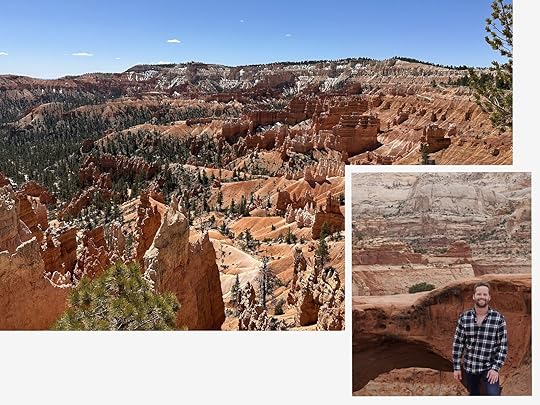
Photo: Johnny Motley
The seven-hour drive from Phoenix to Escalante cuts through the heart of Arizona’s red, saguaro cacti-strewn desert. For a lunch break or stroll to stretch the legs, stop in Tombstone, a charming desert town and the setting for the eponymous cult-classic Western.

Photo: Johnny Motley
Southern Utah, a swath of badlands, mesas, and gnarled canyons, was one of the last pockets of the Lower Forty-Eight to be settled. Escalante is hardly more than an outpost, but nearby Bryce Canyon National Park draws enough visitors for the town to support an excellent coffee shop, Escalante Outfitters, and a funky, gourmet general store, Escalante Mercantile.
Ofland Escalante is a glamping retreat par excellence, treating guests to jacuzzis, outdoor fire pits, and cabins blending rustic charm with refinement. Light-years removed from the rush and roar of modern civilization, Ofland is tailor-made for devouring books, snuggling up with a lover, and sipping wine under starry skies. Ask the concierge about guided tours of Bryce Canyon National Park and Spooky Canyon, a narrow gorge slashing through the badlands.
More like thisTravelBryce Canyon Country Is the Perfect, Less-Crowded Alternative to the Grand CanyonPark City, UtahDistance from Escalante: 280 miles
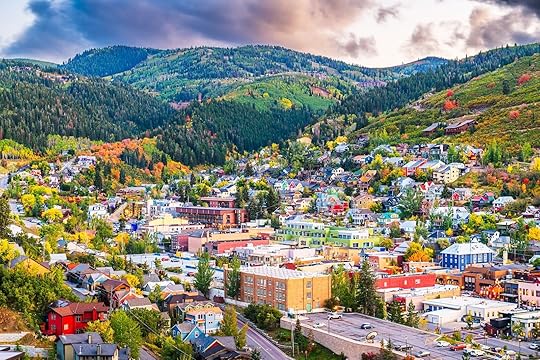
Photo: Sean Pavone/Shutterstock
What comes to mind when you think of dining and drinking in Utah? Strict alcohol guidelines of 2 percent ABV “near beer”? Jello salad paired with funeral potatoes? Park City, a vibrant ski town outside Salt Lake City, shatters these stereotypes. While Park City is world-famous for skiing, the town’s rip-roaring saloons and gourmet restaurants make it as appealing to epicureans as to powderhounds.
Imagine cowboy chow—buttermilk fried chicken, wood-fired steaks, and lamb shanks—but prepared by a chef trained at Le Cordon Bleu. That’s the vibe at Handle, an upscale restaurant in downtown Park City. While slicing into perfectly charred steaks, sampling boards of local charcuterie, and sipping choice pours from High West Distillery, save room for the bourbon-infused bread pudding.
If the whiskey world were to convene a Holy Synod, they would sanctify High West Distillery in Park City as an international shrine. High West produces world-class ryes and bourbons year after year, with whiskeys often aged in ex-Port and ex-sherry casks. Indulge in rare pours of High West on a distillery tour or at , a watering hole worthy of Park City’s early history of outlaws and rowdy miners.
Hotels can be pricey in Park City, especially during the high season of winter, but the Marriott Mountainside is affordable, comfortable, and located within walking distance of Park City’s liveliest streets.
More like thisEpic Stays11 Park City Airbnbs for the Perfect Mountain Getaway, Big Groups WelcomeSalt Lake CityDistance from Park City: 32 miles

Photo: Sean Pavone/Shutterstock
The final stop on my western highway odyssey was Brother Brigham’s New Zion on the Great Salt Lake. Like the poet Walt Whitman, Salt Lake City contains multitudes — sometimes contradictory elements juxtaposed harmoniously. It serves as the headquarters of the Church of Jesus Christ of Latter-day Saints, yet it is also one of the most LGBT-friendly cities in the country. While many residents abstain from alcohol, the city boasts a dynamic craft cocktail and brewery culture. Additionally, Salt Lake City is an excellent launching point for exploring nearby national parks such as Zion and Arches.
Water Witch Bar is an SLC institution for innovative craft cocktails and small bites. Try the Jicara cocktail, a weekly special served in a dried gourd in homage to Utah’s Indigenous culture. Utah nails downhome diner classics like smash burgers (always served with fry sauce), fried chicken, and meatloaf. Stop by The Copper Onion for soul-satisfying All-American fare jazzed up with epicurean flair.
More like thisEpic StaysSalt Lake City Airbnbs to Base Your Utah Adventure Trip
Photo: Matt Morgan
For an only-in-Utah experience, visit Ogden, a small town 40 miles outside SLC. Ogden, once a bustling junction on the transcontinental railroad, has seen its share of economic vicissitudes over the decades, but its rich history, architecture, and breweries make it well worth a day trip. After admiring the magnificent architecture of Main Street and the railroad depot, tie one on at Roosters Brewing Co., a brewery serving splendid suds paired with pub grub like bacon mac ‘n’ cheese, wings, and smothered enchiladas. 
Rivian to Open First-of-Its-Kind EV Charging Center and Hub in Groveland, California

The future of fueling up on the road will look much different than today’s gas stations. But what, exactly, will change? Electric vehicle maker Rivian has more than a few ideas, and will debut them in a new EV charging center in Groveland, California, just west of Yosemite National Park and near many of the park’s closet accommodations.
Given the nature of electric vehicles taking longer to top off than those with internal combustion engines, travelers will need a place to spend half an hour or so rather than just a few minutes. The facility, dubbed The Outpost, will operate as both a charging center and community hub. Customers can learn about EV charging and road trip basics, enjoy coffee and other food and beverage options more akin to a simple cafe than a typical convenience store, and spend time planning their trip into Yosemite or elsewhere while their car juices up.

Rendering of the interior of Outpost. Courtesy Rivian
For the project, Rivian repurposed an existing building that throughout its history has served as a blacksmith shop, a repair shop, and a gas station, retrofitting it for a future continuing to assist travelers and outdoor adventures en route to the nearby national park and beyond. Rivian hopes to open more Outpost locations in the future. Drivers of all types of electric vehicles, not just Rivians, will be able to enjoy the amenities, though The Rivian Adventure Network of DC fast chargers is currently open only to Rivian drivers. The company plans to open the network to drivers of other electric vehicles later this year. Rivian owners don’t even need to touch a button to charge at Outpost or any of the forthcoming 3,500+ chargers in the network, which will be installed in the coming years at approximately 600 initial sites along popular routes and highways. Rivian drivers can add up to 140 miles of range in 20 minutes, according to the company.

Photo Sara Essex Bradley, courtesy Rivian
This first Outpost will produce zero emissions in its daily operations, thanks to a donation from US Solar. The building will be outfitted with enough solar power to cover what it uses, which given its primary purpose as a place for drivers to charge their cars, is set to be a lot. Snacks look to be available in bulk, avoiding the use of single-use plastic bags as much as possible. Travelers will also have the opportunity to stock up on simple adventure basics and souvenirs – think t-shirts and reusable water bottles. 
July 18, 2024
The US National Park Service Just Added a New Site in Marfa, Texas

As of July 17. 2024, the US National Park Service now has 430 sites across the country.
The newest addition is the Blackwell School in Marfa, Texas, designated as the Blackwell School National Historic Site this July. The bill to honor the site was passed in Congress and signed by President Biden in 2022, but it stipulated that the historic schoolhouse wouldn’t officially become part of the National Park Service until ownership of it transferred to the federal government — which just happened in July 2024.
Built in 1909, the adobe brick structure served as the sole public education institution for Marfa’s Hispanic students from that year until 1965. Today, it’s a landmark in the tiny town of Marfa, and a museum to the history of the building and challenges children faced in the era of segregation of Mexican and Mexican-American students.
View this post on Instagram
A post shared by National Park Service (@nationalparkservice)
Though Texas had no laws mandating separate schools, the practice of de facto segregation prevailed throughout the South in the middle of the 20th century, and Marfa was no exception. Following the construction of a new school for European-descended students in 1892, Hispanic children continued attending school in the town’s original school building. However, by 1909, the need for a dedicated space arose, leading the district to construct the two-room schoolhouse that became known as the Ward or Mexican School. It was later named the Blackwell School after Jesse Blackwell, a longtime principal beloved at the school.
The Blackwell school tells a story of a changing time, as it both provided benefits to students, and represented a continuation of the racist principle of “separate but equal.” It was a source of educational opportunities for a marginalized community with a rigorous curriculum, and served as meetinghouse to celebrate Mexican heritage in Marfa, with alumni and their descendants still living and working in the town today.

Photo: The Blackwell School National Historic Site/NPS
However, the school also embodied the discriminatory practices of the era. Students faced strict punishments and were actively discouraged from speaking Spanish. Teachers even held mock funerals where Spanish words were buried, signifying the attempted suppression of their cultural identity.
The Blackwell School closed in 1965 when Marfa’s public schools became fully integrated. In 2006, alumni founded the Blackwell School Alliance, which worked with the National Parks Conservation Association to lobby to make the school into a federally protected site. Today, it’s only the second site managed by the National Park Service that celebrates Latino history, joining the César Chávez National Monument in California. 
Matador Network's Blog
- Matador Network's profile
- 6 followers



